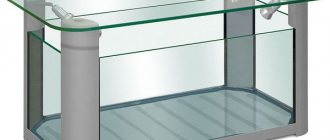An electric water heater for an aquarium is designed to maintain the temperature background necessary for the growth of plants and animals.
The equipment can be installed both inside and outside the tank; there are factory-made devices and home-made installations.
Water heater for heating water in an aquarium.
Reasons and need for use
The air temperature in the room reaches +26°...+28°C in the summer and drops to +20°C the rest of the time (with the heating turned off or not working correctly).
Summer values do not have a negative impact on tropical fish and plants in aquariums, but when the temperature drops, a water heating system in the aquarium is required.
Otherwise, the risk of partial or complete loss of flora and fauna in the reservoir increases. Heating ensures not only maintaining a stable temperature, but also convection mixing of water layers.
Water heater device
A classic immersion heater consists of an outer glass flask of an oblong configuration with sealed plugs. Inside there is a nichrome spiral wound on a metal core through a layer of insulator.
When voltage is applied, the coil and core heat up, thermal energy is transferred to the body, and then increases the temperature of the water.
To regulate operation, a sensor is used that determines the degree of heating of the liquid and automatically turns the power on or off, reducing the risk of overheating and fire of the equipment.
Thermostat and its types
Devices for setting temperature conditions are divided into categories:
- With a mechanical operating principle, they are characterized by simple design and reduced cost. Due to the use of contacts, they do not provide high accuracy of adjustment (the error is up to 3°C); it is recommended to install a thermometer to check the temperature of the liquid.
- Electronic, equipped with an information display. The equipment is characterized by increased adjustment accuracy, but high price and average reliability limit its distribution.
Regardless of the type of measuring unit, regulators are divided into remote and built-in.
External devices are installed on the wall of the aquarium; the absence of exposure to water and waste products of fish and plants allows you to increase the resource, but it is necessary to pre-mount a temperature sensor with a switching wiring harness in the tank.
Built-in products are located in a single heater housing, which eliminates unnecessary cables and reduces the size of the water heating system.
Electronic water heater with display.
Types of thermostats in a submersible aquarium heater
1. Electronic. They have the highest accuracy in determining water temperature. They are expensive. Modern European models are also distinguished by high reliability and stable operation. Most often, the material used to make such devices is plastic.
2. Mechanical. Compared to electronic heaters they have a more reasonable price. Due to the error of the relay for adjusting the heating, at first it is worth monitoring the heating of the water using a separate aquarium thermometer. Most often, the material used to make such devices is a glass bulb.
Types of aquarium heaters
To heat aquariums, several types of heaters are used, differing in design and installation method:
- for external mounting, mounted under the base of the aquarium or in the external filter housing;
- with a location in the water column, there are products with bodies made of different materials;
- flow type, heating the flow of water passing through the block;
- bottom, which are heating cables hidden in the thickness of stones or soil.
External
The external heater is located inside the filter housing, installed outside the aquarium body. The water is purified from foreign impurities and at the same time heated to a preset temperature (the design includes a sensor for automatic power control).
There are designs in the form of a rubber or plastic platform with nichrome threads located inside, on which the container is placed.
The disadvantage of the design is low efficiency; most of the thermal energy is dissipated and spent on heating the glass base of the aquarium.
External type of water heater.
Submersible
Immersion-type products are divided into categories based on body material:
- Made of heat-resistant glass, resistant to external mechanical influences. The device is adjusted to the required liquid temperature, the power is turned on and off automatically (provided the plug is installed in the outlet).
- Made from impact-resistant plastic that can withstand heat. They are characterized by reduced dimensions and reduced weight, and have improved sealing of the internal cavity of the casing. The circuit includes a sensor to maintain the set temperature.
- Made of titanium, designed for heating liquid in large-volume aquariums (for example, for breeding large marine or freshwater fish or turtles).
- Small-sized devices with a flat body made of heat-resistant plastic, designed for installation on the surface or in the thickness of the soil. They are distinguished by reduced power, designed for tanks with a volume of up to 50 liters.
Submersible water heater.
Flow-through
Flow-type equipment consists of a housing with a heating element and a channel through which water passes. The power supply is turned on automatically when the movement of the liquid is detected, which is pumped by a small-sized rotary pump.
The disadvantage of the products is the increased energy consumption of the heating coil; some owners criticize the equipment for the extraneous high-frequency noise of the pump motor.
Instantaneous water heater for an aquarium.
Donny
Bottom-type products are located in the ground and provide convection circulation of layers of water having different temperatures.
The equipment allows you to heat the lower layers of the liquid, but for full heating it is recommended to install an additional flow-through or immersion type unit. The disadvantages of the design are increased energy consumption and the inability to work in fine sand.
Bottom heater for an aquarium.
Aquarium thermostats
In conventional devices, after reaching the set temperature, it continues to work and heat the liquid. It must be constantly turned off, then turned on again, so that the water does not have time to cool down.
There are different types of aquarium heaters with a thermostat:
- Electronic thermal heaters. High accuracy, but high cost.
- Mechanical. They cost much less than their electronic counterparts, but they are often mistaken in their readings by several degrees.
We have already mentioned that the thermostat in the heater is a necessary and important thing, because it independently monitors the water, heating it if necessary, which prevents temperature surges. You certainly won’t be able to constantly be near the aquarium and control everything. But the thermostat can.
According to manufacturing technology, such a device is of two types:
- Electronic. Highly accurate. Most representatives are equipped with information displays. True, such a thermostat is not cheap. It is also considered not reliable enough.
- Mechanical. The most common thermostat. It costs less, it is called stable and reliable. Although sometimes it distorts the correct readings, but only by a couple of degrees (use a separate thermometer for precise adjustments).
In addition, thermostats differ in their level of safety and duration of use. There are remote regulators that are mounted outside the tank, and built-in ones that are mounted in the housing along with the heating element.
The second option is very common among aquarists, since such a heating system is convenient to use. As they say, two in one.
Pros and cons of the device
Advantages of electric heaters:
- maintaining the required water temperature;
- the presence of a heating intensity control system;
- ease of installation and operation.
Equipment disadvantages:
- the need to manually configure equipment due to daily changes in ambient temperature;
- the risk of overheating of the liquid in the aquarium due to breakdown or malfunction of the regulator;
- In the event of a short circuit, the death of the inhabitants of the aquarium is possible.
Calculation of parameters for a specific aquarium
For the calculation, a table is used that takes into account the capacity of the tank and the difference in temperature between the water and the environment. In large aquariums (with a capacity of more than 100 liters), it is necessary to install 2 or more heaters.
To measure the temperature of the liquid, use a mercury, alcohol or electronic thermometer located in the lower layers of water. Below is an example of a table suitable for calculations.
The operator on duty at the KVANTA + online store will help you determine the parameters and choose the appropriate heater model.
| Temperature difference, °C/volume, l | 2 | 6 | 10 |
| 20 | 5 | 17 | 28 |
| 60 | 12 | 35 | 58 |
| 100 | 17 | 48 | 80 |
How to properly install a heater: a step-by-step guide
There is no problem in installing a water heater correctly - it is perhaps the easiest device to install for an aquarium, except for a thermometer.
⚫ Checking network requirements. Before installing an aquarium heater, read the instructions and its technical approval. Standard models are powered by AC power and do not require the installation of adapters. An important condition when carrying out any manipulations with the heater is to disconnect it from the power supply. It is strictly prohibited to turn on the device if it is not completely immersed in water. Remember about safety precautions: if you have the slightest suspicion that a heater or other electrical appliance is malfunctioning, do not put your hand in the water until you turn it off. Any damage to the wire is grounds for replacing the device with a new one. It is not recommended to carry out even minor repairs to heating equipment for an aquarium, otherwise the fish can just as easily be released into the bathtub with a hairdryer turned on. ⚫ Pre-installation. Attach the supplied suction cups to the bracket. Screw the bracket over the top end of the heater or insert the flask into it, depending on the configuration of the fastener. That's all!
⚫ Immersion of the device. The minimum water level provided for placing the heater is usually indicated on the body using a special mark under the adjustment handle. Remember that the higher the temperature of the water, the faster it evaporates and the more often it needs to be topped up. Otherwise, the heater may be above the water level, which is prohibited by the user manual. Immersing the device to a depth of more than 80 cm is also not recommended - more accurate information about each model is contained in the instructions for it.
The design features of the device allow it to be placed not only vertically, but also horizontally in order to disguise it or effectively use the area of the side walls. Never bury the heater in sand or fine gravel! Do not place the device in the “dead” zone of the aquarium, where there is no water circulation - in this case, its actual benefit will be reduced several times.
⚫ Temperature equalization. Before turning on the device, leave it in water for 15 minutes so that the body reaches the same temperature as the environment.
⚫ Turn on. Insert the plug into the socket and wait until the indicator reaches the required level. Check the thermometer readings with the desired temperature several times to ensure that the device is not defective.
In our store you can buy
thermostats heaters thermostats
Installation and rules of use
The device must be mounted on suction cups on the lower part of the rear wall of the tank; the body is installed horizontally to improve convection mixing of the water layers.
If the aquarium has a filter, then it is necessary to direct the outlet pipe to the heating element, which improves the quality of heating the liquid throughout the entire volume. Before testing, rinse the housing with running water and place it in the aquarium to equalize the temperatures.
It is recommended to remove the fish from the tank, as a faulty device may cause an electric shock. Then you should set the required temperature and turn on the power (the test lasts up to 40 minutes).
If no malfunctions are detected, then the inhabitants can be launched back. During operation, the housing should be regularly cleaned of deposits (the frequency specified by the manufacturer in the instructions).
Installing a water heater in an aquarium.
Temperature adjustment
When setting, it is necessary to take into account the measurement error, which is 1°...2°С upwards. For example, instead of the required +28°C, they set +26°C, and then check the result with a thermometer.
The automatic sensor maintains the set value, but if the ambient temperature rises (for example, due to heating or direct sunlight), the water may overheat.
Installation
To maintain the desired microclimate in the aquatic environment, you need to know how to install a heater in an aquarium. The water heater can be installed in both horizontal and vertical positions. When installed vertically, the adjustment handle should be located above the water level. When positioned horizontally, the heater is completely immersed in the aquatic environment.
The body of the heater is usually marked with water immersion level marks. The appliance must be installed so that the water is above the minimum immersion level. Over time, water evaporates, so you need to ensure that it does not fall below the minimum level.
The heater must not be installed in gravel or sand.
A bracket is installed under the heater head, which is attached to the wall of the aquarium using suction cups.
Please note that the installed device can only be turned on after 15-20 minutes. During this time, the temperature of the heater will become equal to the temperature of the water in the artificial reservoir. Only after this the device is connected to the network.
Aquarium heater maintenance, repair
During operation, it is necessary to clean the surface of the heater from deposits that impair heat transfer and destroy the sealing collars.
Vinegar is used to treat glass products, and traces of salt can be wiped off with a soft brush. To remove deposits from plastic or elastomers, use ethyl or isopropyl alcohol.
Electrical components may be treated with special solutions that do not adversely affect performance.
Since the equipment has a sealed housing, repairing components is difficult. Owners can change elements located outside the instrument casing (for example, a temperature sensor or plug).
It is allowed to lengthen the power cables with subsequent insulation of the joint (the modified wiring must be outside the liquid layer).
Selecting heater power
How to choose a heater for an aquarium? One of the main parameters of the equipment under consideration is power.
The device is selected depending on the volume of the artificial reservoir: if the vessel is small, then you will need a heater for a small aquarium of low power, for a large volume - a more powerful device of the appropriate size.
To make the right choice, manufacturers must indicate on the packaging the characteristics of the device, which can be used to understand how many watts are needed to warm up the reservoir and which device is most suitable in a particular case. The following must be taken into account: if you install a too powerful heater in the aquarium, it will not provide optimal temperature conditions, since the water will heat up quickly and the device will constantly turn off.
The larger the volume of the aquarium, the more powerful the heater should be.
To protect yourself and your inhabitants from electric shock, the aquarium heater must be equipped with a special grille, which plays the role of protecting the fish from burns. When choosing the power of the heater, one should proceed from the following considerations: the water temperature should be at a constant level, regardless of external conditions. If the volume of the reservoir is large, it is recommended to install not one water heater for the aquarium, but two, but of lower power. In this way, it will be possible to achieve uniform heating of the liquid.
Regardless of what equipment is used, a separate thermometer is installed in the artificial reservoir, which will be used to control the temperature.
It is worth adding that as the device is used, plaque, algae, and food residues appear on it. This means that the device requires periodic cleaning, but complete disassembly should be avoided. How to properly clean a heater? For these purposes, it is enough to wipe the outside surface with a damp sponge and rinse in clean water. For more information about the right choice, watch this video:
It is better to immediately choose good quality water heaters, taking into account the volume of the aquarium and the necessary conditions for underwater inhabitants, since their normal maintenance and development depend on the correct choice.
Device selection criteria
When selecting a heater, take into account:
- power consumption, which should be in the range from 10 to 100 W (when calculating, take the parameter at the level of 0.7-1.0 W per 1 liter of water);
- the dimensions of the aquarium (for example, a submersible product must be completely under water);
- type of liquid in the container (sea water requires salt-resistant equipment);
- the presence of an emergency shutdown device (for example, a fuse that breaks the power circuit in the event of a short circuit);
- presence of smooth heating temperature control;
- quality of manufacture of the casing and electrical wiring (short circuit due to poor insulation leads to the death of animals in the aquarium and overload of the home network).
How to properly install a heater in an aquarium?
Depending on the installation method, there are 2 types of aquarium water heaters:
- Non-submersible. These models go down to a certain point. The upper part of the device is above the surface.
Important! The disadvantage of non-submersible devices is their short service life.
- Submersible. Such devices have a longer service life because they are completely submerged in water.
How to properly install a heater in an aquarium?
- The device cannot be installed close to the surface, since during evaporation its upper part may be exposed to air, which leads to failure of the heater.
- Do not install the tube at the bottom of the aquarium. The minimum distance from the bottom is 20 mm.
- The tube is installed near the oxygen filter. Air emissions contribute to uniform heating of the water mass throughout the aquarium.
- After the device is installed, you cannot immediately connect it to the network. Keep the time for about half an hour. In this case, the temperature of the heater and the medium will be equal.
Important! If you do not wait this time, the glass may crack. If you want to clean the aquarium, the device must be turned off.
Popular models of aquarium heaters
The online store offers heaters from the following companies:
- Juwel Aquarium, which has been producing aquarium equipment for 50 years;
- Tetra, offering professional water purification and heating systems;
- Polish Aquael, which produces equipment for aquariums with a volume of 10 liters or more;
- JBL Pro Temp, which produces heaters for home and industrial use.
Juwel
The company offers digital thermometers and equipment in the Aqua Heat series with automatic control, having a power of 50, 100, 200 and 300 W.
The degree of heating can be adjusted, the body is made of laminated impact-resistant glass (meets the requirements of German safety standards TUV/GS). The manufacturer offers aquariums with a special compartment for installing a water heating system.
Devices from Juwel.
Tetra
Products of the TetraHT series with power from 25 W are supplied under the Tetra brand, characterized by improved housing sealing. The manufacturer allows long-term operation of the equipment in thick water without the risk of liquid leakage or short circuit.
There is a red control LED that operates when power is applied. An additional advantage is the extra long power cord with elastic, waterproof insulation.
The devices allow you to heat water up to +31°C; the kit includes suction cups for installation on the glass of the aquarium.
Tetra water heaters.
Аquael
The Aquael company offers heaters of the Ultra, Platinum Heater, Comfort Zone Fix and Gold series, which differ in design and performance characteristics.
The equipment is designed to heat water to a temperature of +33°C (adjustment accuracy - 0.4°C). The design uses ceramic radiators and built-in thermometers.
Water heaters of the Aquael brand.
JBL Pro Temp
The company offers a line of Pro Temp equipment with power up to 500 W (flow-through and standard types). An information display is provided, the adjustment step is 1°C, and the flow device kit includes adapters for installation on hoses.
Water heaters from JBL Pro Temp.











